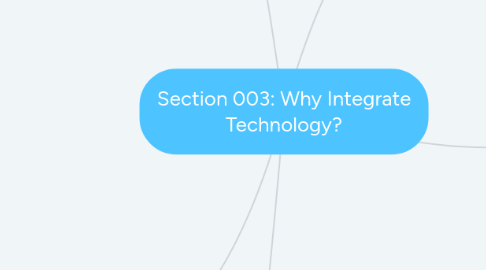
1. Teaching Should Be Different
1.1. Model Technology
1.2. Need to be able to use & integrate technology
1.3. Make Learning More Effective
1.4. Universal Design for Learning
1.4.1. Multiple means of Representation
1.4.1.1. This is the "What" of learning
1.4.1.2. This principle works with the recognition network of the brain
1.4.1.3. We need to present information and content in different ways.
1.4.2. Multiple means of Action and Expression
1.4.2.1. This is the "How" of learning
1.4.2.2. This principle works with the strategic network of the brain
1.4.2.3. We need to differentiate ways that students can express what they know.
1.4.3. Multiple means of Engagement
1.4.3.1. This is the "Why" of learning
1.4.3.2. This principle works with the affecitve network of the brain
1.4.3.3. We need to stimulate student interest and motivation for learning by using multiple means of engagement.
1.5. Digital Video
1.6. Digital Video
1.6.1. Facilitating thinking and problem solving
1.6.2. Assisting with mastery learning
1.6.3. Inspiring and engaging students
1.6.4. Authentic learning opportunities
2. Standards are Different
2.1. ISTE Standards
2.1.1. Copyright & Fair Use
2.1.1.1. Students
2.1.1.1.1. 2b: Digital Citizen: Engage in positive, safe, legal and ethical behavior when using technology.
2.1.1.1.2. 2c. Digital Citizen: demonstrate an understanding . . .
2.1.1.1.3. 2d. Digital Citizen: Manage their . . .
2.1.1.2. Educator
2.1.1.2.1. 3a. Citizen: Create experiences for learners to make positive, socially responsible contributions and exhibit empathetic behavior online that build relationships and community.
2.1.1.2.2. 3c. Citizen: Mentor students in the safe, legal and ethical practices with digital tools and the protection of intellectual rights and property.
2.1.2. Safe Use of the Internet
2.1.2.1. Students
2.1.2.1.1. 2a. Digital Citizen: a. cultivate and manage their digital identity and reputation and are aware of the permanence of their actions in the digital world.
2.1.2.1.2. 2b. Digital Citizen: Students engage in positive, safe, legal and ethical behavior when using technology, including social interactions online or when using networked devices.
2.1.2.2. Educator
2.1.2.2.1. 3a. Citizen: Educators Create experiences for learners to make positive, socially responsible contributions and exhibit empathetic behavior online that build relationships and community.
2.1.2.2.2. 3b. Citizen: Educators model and promote management of personal data and digital identity and protect student data privacy.
2.1.3. Cyberbullying
2.1.3.1. Students
2.1.3.1.1. 2a. Digital Citizen: Students cultivate and manage their digital identity and reputation and are aware of the permanence of their actions in the digital world.
2.1.3.1.2. 2b. Digital Citizen: Students engage in positive, safe, legal and ethical behavior when using technology, including social interactions online or when using networked devices.
2.1.3.2. Educator
2.1.3.2.1. 3a. Citizen: Educators create experiences for learners to make positive, socially responsible contributions and exhibit empathetic behavior online that build relationships and community.
2.1.3.2.2. 3c. Citizen: Mentor students in the safe, legal and ethical practices with digital tools and the protection of intellectual rights and property.
2.2. Ohio Learning Standards (Subject Level)
2.3. Ohio Technology Standards
3. Skills are Different
3.1. Skills are Evolving
3.2. Need Real-world Technology
3.3. 21st Century Skills
3.3.1. Creativity & Innovation
3.3.2. Communication & Collaboration
3.3.3. Research & Information Literacy
3.3.4. Critical Thinking
3.3.5. Linear Thinker
3.3.6. Nonlinear
3.3.7. Visual Literacy
3.3.8. Visual Thinking
3.3.9. Spatial Thinking
3.3.10. Digital-Age Reflection
4. The World is Different
4.1. Globalization
4.2. Changing Workplace
5. Students are Different
5.1. Digital Natives
5.2. Think Differently
5.3. Multitaskers
5.4. Multimedia Oriented
5.5. All Types of Learners
5.5.1. Intelligence Preference
5.5.2. Culture, Ethnicity, & Language
5.5.3. Autism
5.5.4. ADD/ADHD
5.5.5. Intellectual Disabilities
5.5.6. Learning Disabilities
5.5.7. Learning Style
5.5.8. Students at-risk
5.5.9. Gifted and Talented
5.5.10. Physical Disabilities
